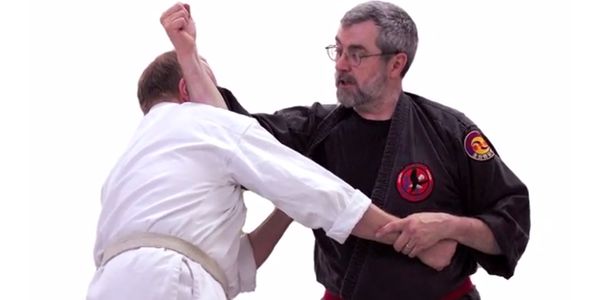Chris Thomas is sometimes asked, “How come you aren’t a regular columnist for Black Belt or some other magazine?” The answer is that he has to be asked, and the magazine has to survive. From this you might correctly guess that for about two seconds he wrote a regular column. This was back in ’02-’03. The column was an every other month piece which appeared in Martial Arts and Combat Sport under the title “George Dillman’s To the Point, with Chris Thomas.” He wrote 9 columns about Pressure Point Fighting, but MACS went out of business before they were all published (6 were published). Anyway, he thought you might enjoy them.
#1 TO THE POINT
A few years ago I attended a seminar taught by a famous Japanese Shotokan karate Master. During the seminar a black belt raised his hand and asked about a particular kata movement; “Sensei, could that be a strike to the head?” At that moment I became somewhat hopeful. The question showed that this student was troubled by the woefully inadequate explanations for kata movements that he had been given over the years.
#2 TO THE POINT – THE MERIDAN PRINCIPLE IN PRESSURE POINT FIGHTING
People who don’t know much about pressure points are often heard talking “knowingly” about them. It’s easy to spot these “experts” becasue they will speak of pressure points as if they are isolated and independent targets – “Well, there’s a pressure a pressure point here. And there’s another one over here . . . ” The real secret of pressure point fighting is that pressure points are used together to compliment each other. The simplest expression of this concept is, “one point causes pain. Two points cause the pain to meet in the middle. Three points cause a knock out.”
#3 TO THE POINT – THE FIVE ELEMENT PRINCIPLE IN PRESSURE POINT FIGHTING
Using pressure points in combination is the essence of the art of pressure point fighting (which, incidently, is called kysho-jitsu). Previously, we have described the Meridian Principle, attacking pressure points on the same meridian to compliment each other. Another principle is the use of the five elements.
#4 TO THE POINT – THE YIN/YANG PRINCIPLE IN PRESSURE POINT FIGHTING
Probably the most ubiquitous concept in the martial arts is the duality known as yin and yang. Yin and yang are understood philosophically as the primordial forces of balance and interplay. Yin is soft, dark, cool, calm, yielding, insubstancial, feminin. Yang is hard, bright, hot, active, forceful, solid, masculine.
The concept is widely applied in the combative disciplines.
#5 TO THE POINT – THE DIURNAL PRINCIPLE IN PRESSURE POINT FIGHTING
One aspect of pressure point fighting most people have encountered is the principle of time of day. Many old accounts of pressure point techniques insist that points must be attacked at certain times in order to be effective. The theory is that certain areas of the body are especially vulnerable to attack during a specific zodiac-hour (a zodiac hour is 2 hours by a western clock) of the day. For example, the document the Bubishi contains a set of 12 drawings depicting pressure points to attack during each zodiac-hour.
#6 TO THE POINT – THE RULE OF SPECIAL POINTS IN PRESSURE POINT FIGHTING
The essence of pressure point fighting is the coordination of points. Most pressure poing techniques utilize at least 3 points, each on increasing the vulnerability of the next. (A note here: points can be attacked either sequentially, or simultaneously, however, in terms of point selection, we generally think sequentially.) In preceding article, we have described four principles of pressure point fighting.
#7 TO THE POINT – THE EXTRAORDINARY POINTS IN PRESSURE POINT FIGHTING
When properly stimulated, a meridan pressure point will produce four results. These are: Area Control. Kinethetic Response, Systemic Compromise, and Relational Artifact. Consider as a n example, an attack to the point LI-10/Shousanli, located just outside and below the crease of the elbow. First, this strike would cause the muscles of the forearm to crampup, and the elbow to flex. This is the resule of Area Control.
#8 TO THE POINT – ANGLE & DIRECTION IN PRESSURE POINT FIGHTING
One of the most important secrets of pressure point fighting is called “angle and direction”. This refers to the path which must be followed to effectively stimulate a particular point. Very few points are attacked horizontilly or vertically. Most are attacked on some diagonal. An excellent target to focus on as part of a discussion of angle and direction os the nose.
#9 TO THE POINT – REALISTIC TRAINING IN PRESSURE POINT FIGHTING
Critics often say, “Yeah, pressure points may work, but you’ll never hit them under the stress of a real fight. It’s too complicated.” Tell that to an airline piolet. Flying a plane is clearly a difficult and complicated task, so complicated that it should be impossible to actually fly under the stress of an in-flight emergency. yet, airline pilots are able to. Why? Realistic training.



